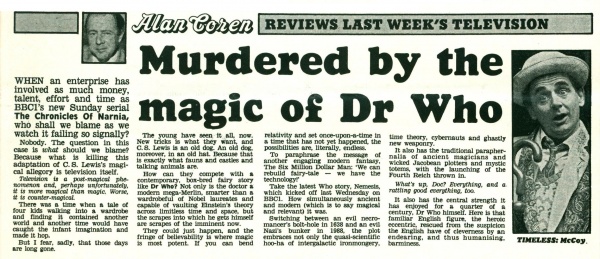Murdered by the magic of Dr Who
- Publication: The Mail on Sunday
- Date: 1988-11-27
- Author: Alan Coren
- Page:
- Language: English
WHEN an enterprise has involved as much money, talent, effort and time as BBC1's new Sunday serial The Chronicles Of Narnia, who shall we blame as we watch it failing so signally?
Nobody. The question in this case is what should we blame? Because what is killing this adaptation of C. S. Lewis's magical allegory is television itself. Television is a post-magical phenomenon and, perhaps unfortunately, it is more magical than magic. Worse, it is counter-magical.
There was a time when a tale of four kids walking into a wardrobe and finding it contained another world and another time would have caught the infant imagination and made it hop.
But I fear, sadly, that those days are long gone.
The young have seen it all, now. New tricks is what they want, and C. S. Lewis is an old dog. An old dog, moreover, in an old hat. Because that is exactly what fauns and castles and talking animals are.
How can they compete with a contemporary, box-bred fairy story like Dr Who? Not only is the doctor a modern mega-Merlin, smarter than a wardrobeful of Nobel laureates and capable of vaulting Einstein's theory across limitless time and space, but the scrapes into which he gets himself are scrapes of the imminent now. They could just happen, and the fringe of believability is where magic is most potent. If you can bend relativity and set once-upon-a-time in a time that has not yet happened, the possibilities are, literally, endless.
To paraphrase the message of another engaging modern fantasy, The Six Million Dollar Man: 'We can rebuild fairy-tale — we have the technology!'
Take the latest Who story, Nemesis, which kicked off last Wednesday on BBC1. How simultaneously ancient and modern (which is to say magical and relevant) it was.
Switching between an evil necromancer's bolt-hole in 1638 and an evil Nazi's bunker in 1988, the plot embraces not only the quasi-scientific hoo-ha of intergalactic ironmongery, time theory, cybernauts and ghastly new weaponry.
It also has the traditional paraphernalia of ancient magicians and wicked Jacobean plotters and mystic totems, with the launching of the Fourth Reich thrown in.
What's up, Doc? Everything, and a rattling good everything, too.
It also has the central strength it has enjoyed for a quarter of a century, Dr Who himself. Here is that familiar English figure, the heroic eccentric, rescued from the suspicion the English have of cleverness by an endearing, and thus humanising, barminess.
TIMELESS: McCoy
Disclaimer: These citations are created on-the-fly using primitive parsing techniques. You should double-check all citations. Send feedback to whovian@cuttingsarchive.org
- APA 6th ed.: Coren, Alan (1988-11-27). Murdered by the magic of Dr Who. The Mail on Sunday .
- MLA 7th ed.: Coren, Alan. "Murdered by the magic of Dr Who." The Mail on Sunday [add city] 1988-11-27. Print.
- Chicago 15th ed.: Coren, Alan. "Murdered by the magic of Dr Who." The Mail on Sunday, edition, sec., 1988-11-27
- Turabian: Coren, Alan. "Murdered by the magic of Dr Who." The Mail on Sunday, 1988-11-27, section, edition.
- Wikipedia (this article): <ref>{{cite news| title=Murdered by the magic of Dr Who | url=http://cuttingsarchive.org/index.php/Murdered_by_the_magic_of_Dr_Who | work=The Mail on Sunday | pages= | date=1988-11-27 | via=Doctor Who Cuttings Archive | accessdate=21 December 2025 }}</ref>
- Wikipedia (this page): <ref>{{cite web | title=Murdered by the magic of Dr Who | url=http://cuttingsarchive.org/index.php/Murdered_by_the_magic_of_Dr_Who | work=Doctor Who Cuttings Archive | accessdate=21 December 2025}}</ref>
